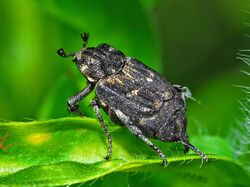Biology:Valgus hemipterus
| Valgus hemipterus | |
|---|---|

| |
| Valgus hemipterus. Male | |

| |
| Female, showing the acuminate telson | |
| Scientific classification | |
| Kingdom: | |
| Phylum: | |
| Class: | |
| Order: | |
| Family: | |
| Subfamily: | |
| Genus: | |
| Species: | V. hemipterus
|
| Binomial name | |
| Valgus hemipterus | |
| Synonyms | |
| |
Valgus hemipterus is a smallish species of scarab beetle (family Scarabaeidae) found in the Northern Hemisphere.
Subspecies
Subspecies include:[1]
- Valgus hemipterus hemipterus (Linnaeus, 1758)
- Valgus hemipterus meridionalis Rössner, 2014
Distribution
This species occurs from the Caucasus and Turkey to North Africa and southern and central Europe (Albania, Austria, Belarus , Belgium, Bosnia and Herzegovina, Bulgaria, Central European Russia, Croatia, Cyprus, Czech Republic, Denmark , European Turkey, France , Germany , Greece, Hungary, Italy, Latvia, Lithuania, Luxembourg, Republic of North Macedonia, Northwest European Russia, Poland , Portugal, Romania, Slovakia, Slovenia, South European Russia, Spain , Switzerland , The Netherlands, Ukraine , Yugoslavia).
The species has been introduced to the Nearctic realm,[2] in parts of North America, especially Ontario, Michigan and Ohio.
Description
This species reaches a body length of 6–10 mm.[3] The basic color is black or dark brown. The scales on the body of the male are dark brown with a light pattern, while most scales in females are dark. Pronotum is rather serrate along lateral edges, a transverse medial ridges is not well developed and basal margin is quite rounded.[4] The elytrae are shortened and do not cover the entire body. Pronotum and elytra show patches of light-colored setae.[4]
Females bear a striking long acuminate telson - unusual fact in Coleoptera - with a central groove near apex and irregular lateral serrations, which makes them easily distinguishable from the males. In addition, The males have a different drawing than the females.[3]
Biology
These beetles, which can be found from May to June[3] on flowers or wood, are relatively common. The species has one generation (univoltine) and hibernates as a pupa.[3]
Adult females usually oviposit to moist, rotting wood and use their acuminate telson to create the site of oviposition.[4] The larvae live in the soil[3] and feed on dead wood of birch and other trees.
Gallery
Bibliography
- Harde, Severa: Der Kosmos Käferführer, Die mitteleuropäischen Käfer, Franckh-Kosmos Verlags-GmbH & Co, Stuttgart 2000, ISBN:3-440-06959-1 (German)
- Möller, G., Schneider, M. (1991): Kommentierte Liste ausgewählter Familien überwiegend holzbewohnender Käfer von Berlin-West mit Ausweisung der gefährdeten Arten (Rote Liste). In: Auhagen, A., Platen, R., Sukopp, H. (Hrsg.): Rote Listen gefährdeter Pflanzen und Tiere in Berlin. - Landschaftsentwicklung und Umweltforschung, Sonderheft 6, 1991: S. 373-420. (German)
- Jiři Zahradník, Irmgard Jung, Dieter Jung et al.: Käfer Mittel- und Nordwesteuropas, Parey Berlin 1985, ISBN:3-490-27118-1 (German)
References
- ↑ Biolib
- ↑ Fauna Europaea
- ↑ 3.0 3.1 3.2 3.3 3.4 Insektenbox (in German)
- ↑ 4.0 4.1 4.2 Generic Guide to New World Scarab Beetles
External links
| Wikimedia Commons has media related to Valgus hemipterus. |
- Beetles (Coleoptera) and Coleopterists
- Valgus hemipterus photos at Beetlespace.wz.cz
Wikidata ☰ Q630316 entry
 |




